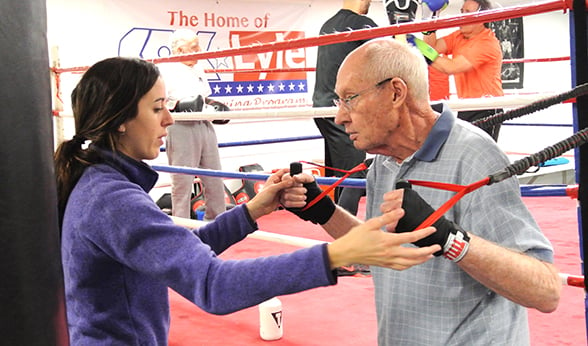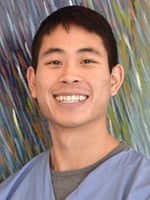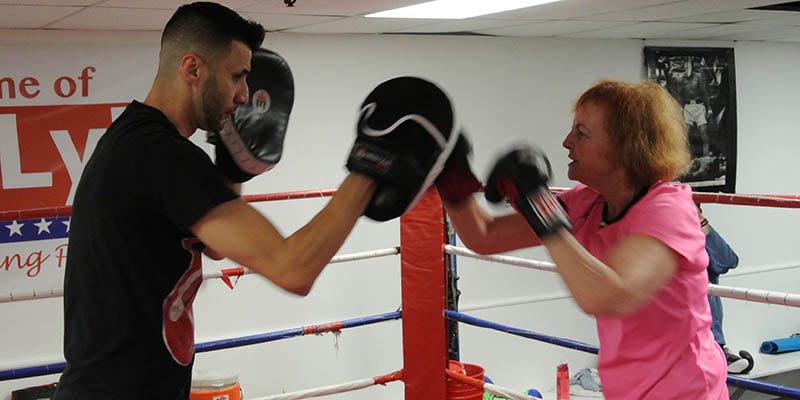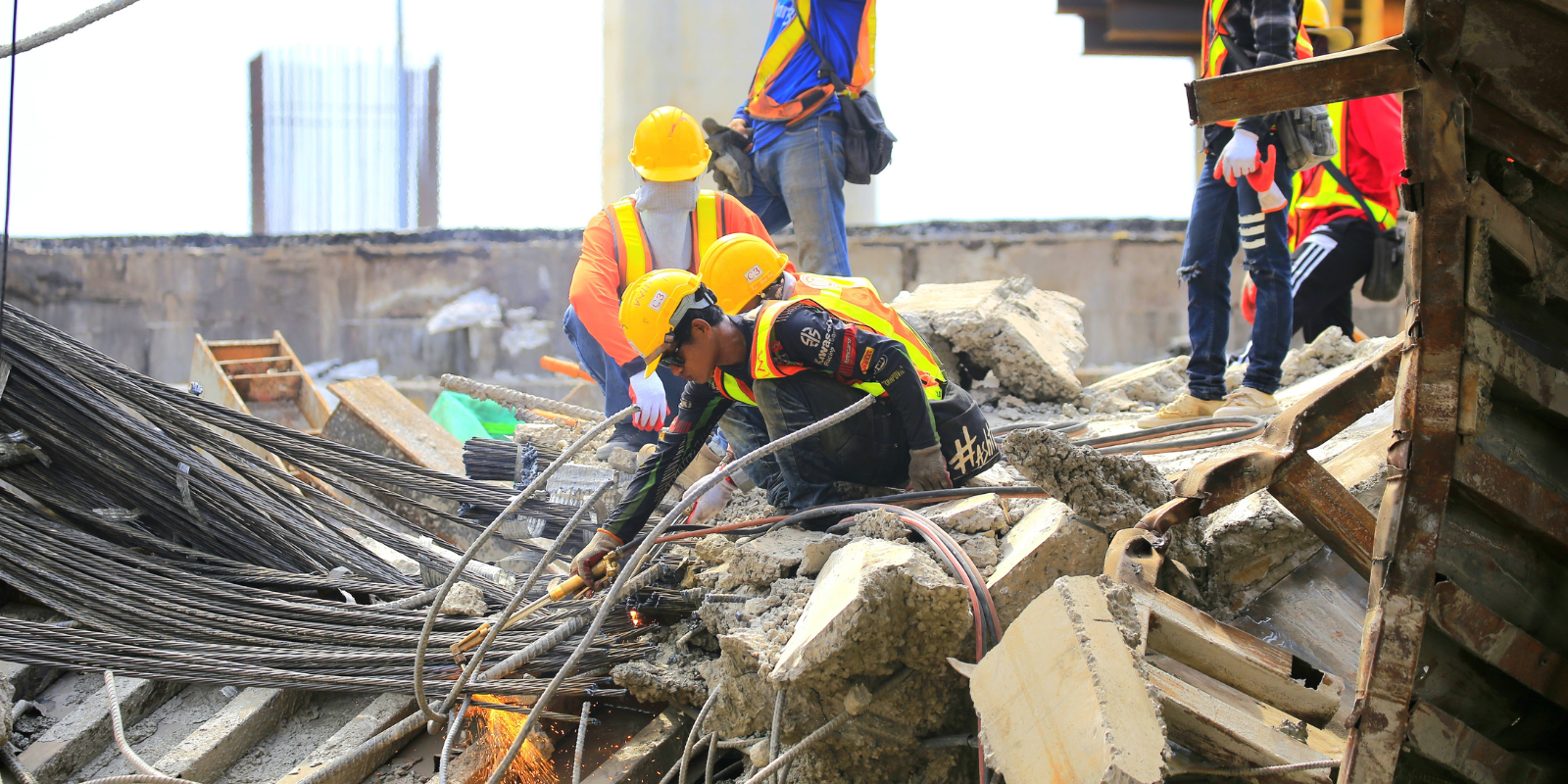With a glint in her eye and clenched jaw, Tina Schoenherr rears back a gloved fist and swings at the target held up by Anthony Mora.
Thuds of fists on punching bags and Mora’s rapid-fire instructions inside the ring – “One-two, Tina! C’mon, one-two!” – fill the basement gym that could easily double as a set for an old-school boxing film, a la “Rocky.” The room pulses with music and motion – mostly middle-aged folks who are strenuously exercising both in and outside the ropes.
It’s another sweat-soaked Saturday of Power Punch Parkinson’s (PPP), but the acronym’s last ‘P’– Parkinson’s – is currently the furthest thing from the participants’ minds.
PPP, a program that gives Parkinson’s patients intensive, non-contact workouts, was co-founded by Mora, former Major League Baseball pitcher Rick Schwartz and Lee Chow, PT, DPT, a 2015 alumnus of the University of Colorado School of Medicine’s Physical Therapy Program. All three men are instructors in the non-profit program, which is sponsored by the Parkinson Association of the Rockies.
While the ground-breaking program they devised may look like boxing, nobody actually gets punched.
CU Anschutz connection
Here at Red Shield Community Center in the Five Points neighborhood, the program is run by Mora and volunteers from the CU and Regis University’s physical therapy programs. Since PPP launched in November 2014, about 100 Parkinson’s patients have participated in the heart of Denver – plus scores more at PPP locations in Boulder, Fort Collins and Colorado Springs – enjoying the fitness and social interaction offered by the weekly classes.
“It’s just been amazing – it’s a fabulous program,” Schoenherr says. “The volunteers from CU and Anthony work with you individually. Now I’ve got stability, I’ve got energy, and my balance is 100 percent better.”
 Sammi Stolper, left, a second-year physical therapy student at CU Anschutz, assists a participant with a workout station at Power Punch Parkinson's.
Sammi Stolper, left, a second-year physical therapy student at CU Anschutz, assists a participant with a workout station at Power Punch Parkinson's.
Sammi Stolper, a second-year physical therapy student at CU Anschutz, got hooked on being a volunteer a year ago. “It’s really the people here that keep you coming back,” she says. “You see incredible changes in the participants. They open up, they punch harder and it carries over to hope for them.”
When she graduates, Stolper would like to replicate the PPP model in her home of Arizona, where no similar program exists.
‘A social outlet’
Schwartz, who pitched for the Cleveland Indians from 1968-71, was diagnosed with Parkinson’s 16 years ago. Three years ago, he got the idea that a fitness program centered on boxing – a sport that demands mobility, strength, coordination and balance – could help Parkinson’s patients. He met Mora, a former professional boxer, at the gym one day and then Cheryl Seifert, executive director of the Parkinson Association of the Rockies, connected the two athletes to Chow, who was working on a business-plan project for one of his physical therapy classes at CU.
“There’s nothing like this program in Colorado,” says Chow, now a physical therapist at Platte Valley Medical Center in Brighton. “It gives people with Parkinson’s a social outlet.”
 Lee Chow, an alumnus of the CU Physical Therapy Program, co-founded the Power Punch Parkinson's program.
Lee Chow, an alumnus of the CU Physical Therapy Program, co-founded the Power Punch Parkinson's program.
Intense aerobic activity has been found, in animal studies, to release protein compounds that make the brain more “plastic” and better able to resist degeneration, Chow says. “Parkinson’s is a progressive disease,” he says, “so a good outcome is to slow or reach a plateau with your symptoms.”
Participants at the basement gym extol the program for giving them confidence, strength and camaraderie.
‘Treats us as athletes’
Hal Pottle comes to the classes twice a week and loves the adrenalized feel of being a boxer. “Everyone here treats us as athletes, not as someone who has Parkinson’s, which is a pretty high honor,” he says.
Valerie Leonard watches her husband, Bob, go through the various workout stations as a peppy Madonna song blares from the speakers. “There’s a lot of camaraderie here,” she says. “It’s almost like a support group, but instead of sitting and talking, they’re working out together.”
 Anthony Mora, right, gives a Power Punch Parkinson's participant targets to punch at during a recent class in Denver.
Anthony Mora, right, gives a Power Punch Parkinson's participant targets to punch at during a recent class in Denver.
Schwartz says the key to PPP’s success – the program has sights to expand to Vail, Grand Junction and Greeley – is the volunteer assistance from the CU Physical Therapy Program. “They’re really dedicated and they make the difference in getting everybody through the system. CU should be proud of them,” he says.
With Parkinson’s, Schwartz says, people aren’t necessarily supposed to get better. But he sees PPP participants gain mental confidence and physical strength all the time. “I’ve seen miracles … I’ve seen people get better, which is the miracle.”
People like Nick Peterson, 65, who learned he had Parkinson’s 41 years ago. “I found out I have a helluva right (hook),” Peterson says with a smile. “This program gives me a feeling of power that I haven’t had in a long time.”



